|
FLAGTAILS (Kuhliidae)
Flagtails are a small family of silvery,
perchlike fishes with a single dorsal fin. The tail fin is banded
in many flagtail species, hence the common name. In Hawaiian species,
however, only juveniles have banded tails.
A Tale of Two Species
Until recently only one flagtail species
was believed to occur in Hawai`i. In the late 1990s, however, aquarium
collector Darrell Takaoka noticed that there seem to be two types
of juveniles in tide pools. Some have black reticulations on their
heads, whereas others have plain heads. He took specimens to Dr.
John E. Randall at the Bishop Museum, who determined that the "zebra-head"
flagtails represent a species not previously thought to occur in
Hawai`i. Investigating further, Randall and his wife found that
the scientific names of both species had been mixed up. The correct
scientific name of the less-common "zebra-head" species--Kuhlia
sandvicensis-- was the name in current use for the more-common
"plain-head" species. The correct name for the common
"plain-head" flagtail turned out to be Kuhlia xenura,
a name long forgotten in the annals of ichthyology. Further confusing
the issue, the zebra-headed sandvicensis (which might expected
on the basis of name to be endemic to Hawai`i) was found to be widely
distributed in the Central Pacific, while K. xenura was found
to be endemic.
Meanwhile, a biology student at Louisiana
State University, Lori Benson, was hot on the same story. In 1999,
while doing research in Hawai`i for her PhD thesis on flagtails,
she was tipped off by local fishermen that there were two types
of äholehole, one with bigger eyes than the other. Suspecting
two species, she procured specimens and submitted tissue samples
for DNA sequencing. In 2001, however, while Benson's studies were
being completed, Randall and Randall published their results in
the journal Pacific
Science. Benson's PhD
Thesis was submitted in 2002. Both studies were completely independent,
and each contains useful ID information not present in the other.
UPDATE:
In March 2019 I received this email:
Just read your tale of two species story for the two Hawaiian species.
Actually the story goes a bit further back.
I was teaching
in the Zoology Department at UH. Some time in the 80's, I had a
student from the Big Island. He fished a lot with his dad and uncles.
The students needed to do a project. He talked to his dad &
uncles about the two kinds of Aholehole that they differentiated.
The way they identified them in the water was where the two kinds
hung out relative to where the waves were breaking. Once caught,
the fishermen also noted some morphological differences between
the two. I said that sounded like a good idea for a project. I really
didn't expect too much (We teachers need to get rid of our preconceived
ideas). He wrote up a great paper that covered lateral line scale
counts eye dimensions relative to the rest of the head, the scrolling
on the top of the head and some really interesting ecological stuff
that would be important to fishermen. At the time Jim Shaklee was
the ichthyologist at HIMB. I gave him the paper and asked what he
thought. He read it and and was very impressed. He told me "Those
are two good species for sure!" Later I think, Jim talked to
Jack Randall about that story and the rest-----is history."
Aloha
Bob Kinzie
How can I tell adults apart?
The Hawaiian Flagtail has larger
eyes than the Zebra-Head--but unless you can see the two together
it's difficult to tell which is which. Under certain lighting conditions
faint dark reticulations can sometimes be seen on adult Zebra-Heads.
Theoretically, adults of the two
species can also be differentiated by the characters below, but
in practice these are difficult to see except perhaps in good photos:
1) dorsal
head profile: the
Zebra-Head Flagtail has a straight dorsal head profile whereas the
Hawaiian Flagtail has a slightly concave dorsal head profile.
2) color: The Hawaiian Flagtail often has an olive or bronze
tinge along the back, and sometimes bronze patches on the side,
whereas the Zebra-Head is more silvery on the back and whitish below.
Also, in the Hawaiian Flagtail the upper edge of the eye reflects
a reddish color in strong light. (See photo at bottom of page.)
3) habitat? As adults, both species seem to prefer turbulent
areas, where they form dense resting schools by day. Some observers
suggest that the Zebra-Head might prefer resting in dark caves by
day while the Hawaiian might prefer resting in the open, but this
has yet to be proved.
HAWAIIAN FLAGTAIL
· äholehole
Kuhlia xenura (Jordan & Gilbert, 1882)
By day, these silvery fish form dense
stationary schools, usually near the tops of reefs or along dropoffs
in areas of heavy surge where turbulence and constant fine bubbles
screen them from predators. Subadults will also school in very shallow
water along protected sandy beaches and in stream mouths. At Honolua
Bay, Maui, they aggregate near submarine freshwater springs. These
resting schools often occupy the same location year after year,
although they sometimes shift locations temporarily. At night the
fish disperse to feed on plankton. The young have banded tails,
but are otherwise plain (in contrast to young Zebra-Head Flagtails
which have black reticulations on the head). Juveniles are abundant
in tide pools; they enter brackish water, and will even penetrate
some distance up streams. In old Hawai`i only the young were called
äholehole; adults were simply ähole. To 12 in. Endemic.
ZEBRA-HEAD FLAGTAIL
· äholehole
Kuhlia sandvicensis (Steindachner, 1876)
This flagtail was only recently identified
in Hawai`i because it is so similar to the Hawaiian Flagtail (above).
However, juveniles in tide pools are easy to identify because they
have a whitish head with wide black reticulations on the upper surface
which extend rearward as two black lines on either side of the dorsal
fin. Also, the tip of the soft dorsal fin is white. These markings
fade on adults, although the dark reticulations are sometimes visible
under certain lighting conditions.
There must be some differences in
behavior and habitat between Zebra-Head and Hawaiian Flagtails,
but if so they remain for the most part undiscovered. Here is some
of what we know so far, according to a PhD
Thesis on these two species by Lori Benson of Louisiana State
University: 1) Juvenile Zebra-Heads sometimes occur near stream
mouths, but they do not actually enter freshwater streams, whereas
juvenile Hawaiian Flagtails are sometimes found well upstream. 2)
Juvenile Zebra-Heads avoid pools that are closed off from the ocean
at low tide, whereas juvenile Hawaiian Flagtails will live in such
pools. 3) Juvenile Zebra-Heads will not seek shelter in cracks and
crevices although juvenile Hawaiian Flagtails will. Benson also
mentions that while adults of both species feed nocturnally, "adult
K. sandvicensis were observed and collected actively feeding
during the day on at least one occasion."
If you have additional information
on the differences between these two species, or good photos of
flagtails in caves, I'd love to hear from you.
|
|
The
photos of juvenile flagtails below are used courtesy of Danene Warnock
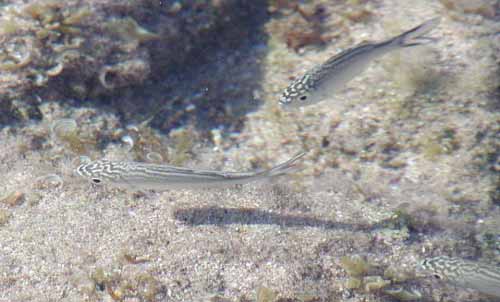
Juvenile Zebra-Head Flagtails in tide pool- Danene
Warnock, Kihei, Maui.
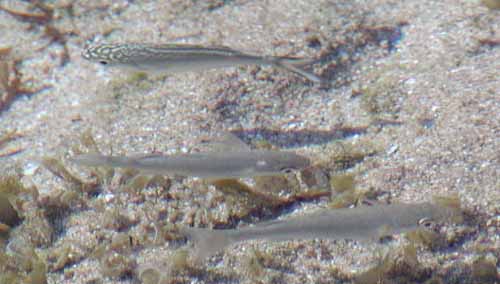
Juvenile Zebra-Head Flagtail (upper fish) and juv.Hawaiian Flagtails
(lower two) in tide pool - Danene Warnock, Kihei, Maui
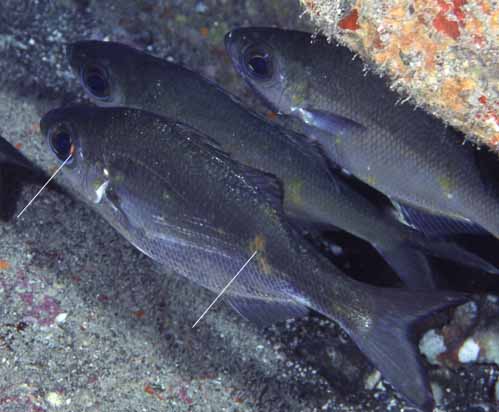
Hawaiian Flagtails - identified on basis of olive patches and reddish
color on upper edge of eye.
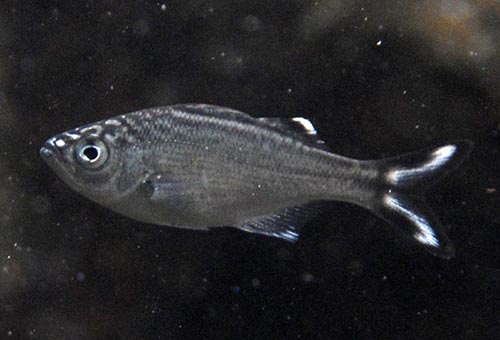 subadult
Zebra-Head Flagtail - Whittington Beach Park, Hawai'i. subadult
Zebra-Head Flagtail - Whittington Beach Park, Hawai'i.
Is
this the end of the flagtail story? Possibly
not. One correspondent reports that giant äholehole,
up to 17 in. long, occasionally turn up in fish markets. Perhaps
these represent a third Hawaiian species.
|
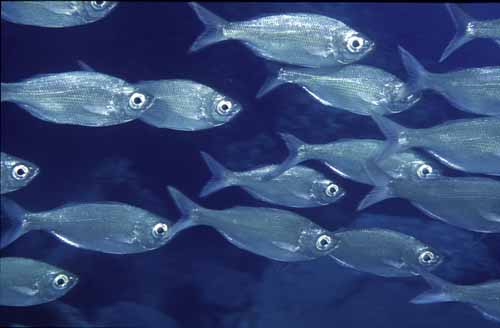
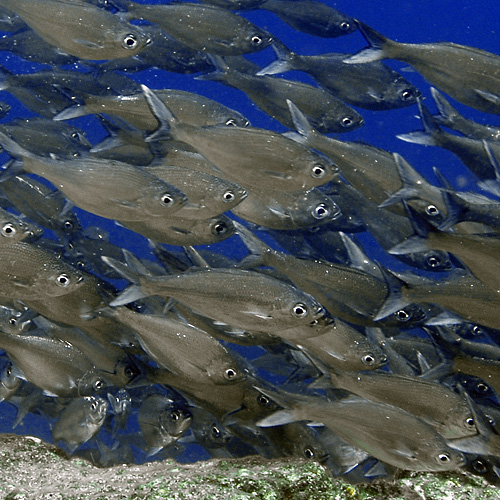



 subadult
Zebra-Head Flagtail - Whittington Beach Park, Hawai'i.
subadult
Zebra-Head Flagtail - Whittington Beach Park, Hawai'i.